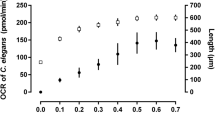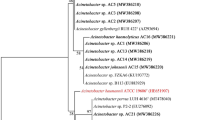Abstract
The interaction of heavy metals such as hexavalent chromium, Cr (VI) with the environment drastically influences living organisms leading to an ecological imbalance. Caenorhabditis elegans, a saprophytic nematode having 60–80% homology with human genes offers a distinct advantage to be used as a biosensor for the appraisal of heavy metal-induced environmental toxicity and risk monitoring. The present study examines the toxicity effects of K2Cr2O7 as Cr (VI) on stress-related gene expression and morphometric parameters of C. elegans under in vitro conditions to identify genetic markers for environmental pollution. Alterations in growth and modified gene expression were observed in Cr (VI)-exposed N2 worms. The 24-h median lethal concentration for Cr (VI) was observed as 158.5 mgl−1. Use of the responses of stress-related gene expression suggests that C. elegans can be used as an efficient biosensor for figuring out the precise route of Cr (VI)-induced environmental toxicity in a quick, simple, and inexpensive manner.
This is a preview of subscription content, access via your institution
Access options
Subscribe to this journal
Receive 6 print issues and online access
$259.00 per year
only $43.17 per issue
Buy this article
- Purchase on Springer Link
- Instant access to full article PDF
Prices may be subject to local taxes which are calculated during checkout




Similar content being viewed by others
References
Stohs SJ, Bagchi D . Oxidative mechanisms in the toxicity of metal ions. Free Rad Biol Med 1995; 18: 321–336.
Ercal N, Gurer HO, Aykin NB . Toxic metals and oxidative stress part I: mechanisms involved in metal-induced oxidative damage. Curr Topics Med Chem 2001; 6: 529–539.
Smith WA, Apel WA, Petersen JN, Peyton BM . Effect of carbon and energy source on bacterial chromate reduction. Bioremed J 2002; 6: 205–215.
Viamajala S, Peyton BM, Petersen JN . Modeling chromate reduction in Shewanella neidensis MR-1: development of a novel dual enzyme kinetic model. Biotechnol Bioeng 2003; 83: 790–797.
Ackerley DF, Gonzalez CF, Keyhan M, Blake R, Matin A . Mechanism of chromate reduction by the Escherichia coli protein, NfsA, and the role of different chromate reductases in minimizing oxidative stress during chromate reduction. Environ Microbiol 2004; 6: 851–860.
Beyersmann D, Hartwig A . Carcinogenic metal compounds: recent insight into molecular and cellular mechanisms. Arch Toxicol 2008; 82: 493–512.
Kaletta T, Hengartner MO . Finding function in novel targets: C. elegans as a model organism. Nature Rev Drug Discov 2006; 5: 387–399.
Willams PL, Anderson GL, Johnstone JL, Nunn AD, Tweedle MF, Wedeking P . Caenorhabditis elegans as an alternative animal species. J Toxicol Environ Health 2000; 61: 641–647.
Menzel R, Rodel M, Kulas J, Steinberg CE . CYP35: xenobiotically induced gene expression in the nematode Caenorhabditis elegans. Arch Biochem Biophys 2005; 438: 93–102.
Reichert K, Menzel R . Expression profiling of five different xenobiotics using a Caenorhabditis elegans whole-genome microarray. Chemosphere 2005; 61: 229–237.
Dhawan R, Dusenbery DB, Williams PL . Comparison of lethality, reproduction, and behavior as toxicological endpoints in the nematode Caenorhabditis elegans. J Toxicol Environ Health 1999; 58: 451–462.
Anderson GL, Boyd WA, Williams PL . Assessment of sublethal endpoints for toxicity testing with the nematode Caenorhabditis elegans. Environ Toxicol Chem 2001; 20: 833–838.
Boyd WA, Williams PL . Comparison of the sensitivity of three nematode species to cooper and their utility in aquatic and soil toxicity tests. Environ Toxicol Chem 2003; 22: 2768–2774.
David HE, Dawe AS, De Pomerai DI, Jones D, Candido EP, Daniells C . Construction and evaluation of a transgenic hsp16- GFP-lacZ Caenorhabditis elegans strain for environmental monitoring. Environ Toxicol Chem 2003; 22: 111–118.
Jones D, Stringham EG, Babich SL, Candido EP . Transgenic strains of the nematode C. elegans in biomonitoring and toxicology: effects of captan and related compounds on the stress response. Toxicology 1996; 109: 119–127.
Stringham EG, Candido EPM . Transgenic hsp16-lacZ strains of the soil nematode Caenorhabditis elegans as biological monitor of environmental stress. Environ Toxicol Chem 1994; 13: 1211–1220.
Castillo J, Gaspar S, Leth S, Niculescu M, Mortari A, Bontidean I et al. Sens. Actuators B Chem 2004; 102: 179–194.
Brenner S . The genetics of Caenorhabditis elegans. Genetics 1974; 77: 71–94.
Zhang L, Jie G, Zhang J, Zhao B . Significant longevity-extending effects of EGCG on Caenorhabditis elegans under stress. Free Radic Biol Med 2009; 46: 414–421.
Brown MK, Evans JL, Luo Y . Beneficial effects of natural antioxidants EGCG and a-lipoic acid on lifespan and age-dependent behavioural declines in Caenorhabditis elegans. Pharmacol Biochem Behav 2006; 85: 620–628.
Smith JV, Luo Y . Elevation of oxidative free radicals in Alzheimer’s disease models can be attenuated by Ginkgo biloba extract EGb761. J Alzheimer Dis 2003; 5: 287–300.
Kandasamy S, Fan Di, Sangha JS, Khan W, Evans F, Critchley AT et al. Tascos a product of Ascophyllum nodosum, imparts thermal stress tolerance in Caenorhabditis elegans. Mar Drugs 2011; 9: 2256–2282.
Livak KJ, Schmittgen TD . Analysis of relative gene expression data using real-time quantitative PCR and the 2(ΔΔC(T)) method. Methods 2001; 25: 402–408.
Bargmann CI, Hartwieg E, Horvitz HR . Odorant-selective genes and neurons mediate olfaction in C. elegans. Cell 1993; 743: 515–527.
Powolny AA, Singh SV, Melov S, Hubbard A, Fisher AL . The garlic constituent di allyl trisulphide increases the lifespan of C. elegans via skn-1 activation. Exp Gerontol 2011; 46: 441–452.
Chu K, Chow K . Synergistic toxicity of multiple heavy metals is revealed by a biological assay using a nematode and its transgenic derivative. Aquat Toxicol 2002; 61: 53–64.
Dowd RM . Biological monitoring. Environ Sci Technol 1984; 18: 215–218.
Smock LA . Relationship between metal concentration and organism size in aquatic insects. Freshwater Biol 1983; 13: 313–321.
Rainbow PS . Biomonitoring of heavy metal availability in the marine environment. Mar Pollut Bull 1995; 31: 183–192.
Williams PL, Dusenbery DB . Aquatic toxicity testing using the nematode Caenorhabditis elegans. Environ Toxicol Chem 1990; 9: 1285–1290.
Ura K, Kai T, Sakata S, Iguchi T, Arizono K . Aquatic acute toxicity testing using the nematode Caenorhabditis elegans. J Health Sci 2002; 48: 583–586.
Cressman CP, III, Williams PL . Reference toxicants for toxicity testing using Caenorhabditis elegans in aquatic media. In Dwyer FJ, Doane TR, Hinman TR (eds). Environ Toxicol Risk Assessment: Modeling and Risk Assessment. American Society for Testing and Materials Philadelphia, PA, USA 1997 pp 518–532.
Anderson GL, Boyd WA, Williams PL . A comparison of metal-induced lethality and behavioral responses in the nematode Caenorhabditis elegans. Environ Toxicol Chem 2001; 19: 3061–3067.
Kohra S, Kuwahara K, Takao Y, Ishibashi Y, Lee HC, Arizono K et al. Effect of bisphenol A on the feeding behaviour of Caenorhabditis elegans. J Health Sci 2002; 48: 93–95.
Tominaga N, Kohra S, Iguchi T, Arizono K . A multigeneration sublethal assay of phenols using the nematode Caenorhabditis elegans. J Health Sci 2003; 49: 459–463.
Anderson GL, Cole RD, Williams PL . Assessing behavioural toxicity with Caenorhabditis elegans. Environ Toxicol Chem 2004; 23: 1235–1240.
Larsen PL . Aging and resistance to oxidative damage in Caenorhabditis elegans. Proc Natl Acad Sci USA 1993; 90: 8905–8909.
Finkel T, Holbrook NJ . Oxidants, oxidative stress and the biology of ageing. Nature 2000; 408: 239–247.
Murakami S, Murakami H . The effects of aging and oxidative stress on learning behavior in C. elegans. Neurobiol Aging 2005; 26: 899–905.
Levis AG, Bianchi V . Mutagenic and cytogenetic effects of chromium compounds. In Langard S (eds). Biological And Environmental Aspect Of Chromium. Elsevier Science: Amsterdam, The Netherlands. 1982 pp 171–208.
Peredney CL, Williams PL . Utility of Caenorhabditis elegans for assessing heavy metal contamination in artificial soil. Arch Environ Contam Toxicol 2000; 39: 113–118.
Leung CK, Deonarine A, Strange K, Choe KP . High-throughput screening and biosensing with fluorescent C. elegans strains. J Vis Exp 2011; 19: 2745–2751.
Acknowledgements
We are grateful to Director CIMAP (CSIR), Lucknow, India for providing necessary facilities. Senior author (SKS) is also thankful to Council of Scientific and Industrial Research, Government of India for providing grant-in-aid.
Author information
Authors and Affiliations
Corresponding author
Ethics declarations
Competing interests
The authors declare no conflict of interest.
Rights and permissions
About this article
Cite this article
Saikia, S., Gupta, R., Pant, A. et al. Genetic revelation of hexavalent chromium toxicity using Caenorhabditis elegans as a biosensor. J Expo Sci Environ Epidemiol 24, 180–184 (2014). https://doi.org/10.1038/jes.2013.66
Received:
Accepted:
Published:
Issue Date:
DOI: https://doi.org/10.1038/jes.2013.66
Keywords
This article is cited by
-
Production, disposal, and efficient technique used in the separation of heavy metals from red meat abattoir wastewater
Environmental Science and Pollution Research (2020)
-
Synthesis, characterization and application of surface-modified biochar synthesized from rice husk, an agro-industrial waste for the removal of hexavalent chromium from drinking water at near-neutral pH
Clean Technologies and Environmental Policy (2019)
-
Adsorption of Zn(II) and Pb(II) Ions from Aqueous Solution Using Chitosan Cross-Linked Formaldehyde Adsorbent to Protect the Environment
Journal of Polymers and the Environment (2019)



